The Hague, July 2011
Imagine this: Its Monday morning in the official headquarters and I’m in the ‘war room’, surrounded by uber-tech computer screens, sitting around a large wood-panelled table. My entire body finds solace in a soft, black leather swivel chair and I sink in, armed for another work week. Chit and chatter fill the air, colleagues at a meeting – planning, sharing and strategizing.
Suddenly, my mouth is light and full of memories. Memories of my mom’s Ogbono soup, steaming with chunks of Norwegian stockfish and beef – unbelievable but true! I imagine a bowl of the gelatinous, orange-brown ‘stew’, flecked with bits of dried red chilli, thickened by the finely ground seeds of a native mango fruit. For in Nigeria, we have ‘eating soups’ (vs. drinking ones) which are, by strict definition stews. I feel the sun beat down my back as I lift and dip morsel after morsel of pounded yam (a thick paste of boiled yams, similar to mashed potatoes) into the perfectly salted soup. In a flash, the vision is gone and I am back to ‘earth’, mouth dry and left longing for a taste of home.
The thought stays all day, through a typical cold Dutch ‘sandwich’ lunch – a soft white roll and a beef croquette (bread-crumbed roll of mashed potatoes and beef, deep-fried). Yum. Food, though that would be ‘strange’ in any Nigerian lunchbox, oft filled with rice and chicken, fried plantain (dodo) and a myriad of other warm meals.
When the day is over, I head home from work with parched throat and a strong desire for home food. Next to me on the bus sits an Iranian friend. We begin talking and I narrate my ‘soup’ dream from earlier on. His comment ‘Maybe it is time to go home’ lodges a wedge deep inside my heart. And quells the panic that grips me when I think about moving back home, to Nigeria.
I arrive home and am thrilled to see my husband has prepared a Nigerian meal for dinner – not the soup I dreamt about but good enough to ease the pain inside. As we sit to eat at our stone table, looking out the wide windows in our open kitchen, I am shocked at how quickly 4 years here have gone by.
Nigeria, October 2011
We’re back, closer to the warmth, sunshine and rain, resident on the equator and only 52 months after our departure.
The constant hum of life is interesting and an octave louder than perhaps we are used to. Blaring horns, sirens (and not only those of ambulances) and other urban sounds dot the scale.
The formerly familiar landscape now holds both delight and surprise for me – gorgeous patterned butterflies and tree squirrels only a smattering of them. There is so much green. Not the green of perfectly manicured lawns in parks and pruned trees but that of vibrant and thriving savannas thick with health and tropical grassland. The trees stand tall and high, surrounded by thickets of grass beneath. One might proclaim this evidence of good living and thank the rain gods who send waters from on high with amazing regularity.
Me? I’m fine, embracing the closed kitchens everywhere – at my sister’s house and now in our transit bungalow. It is wonderful to shut off scents of (pungent) cooking and not worry about smoke-filled living rooms. Unlike in my open Dutch kitchen where sweet and sour fragrances, piling dishes in the sink and bread-crumbed work tops were in full glare of guests and neighbours.
The first soup I make on our return is Ogbono, a soup thickened with the ground seeds of the same name – inner kernels of a variety of African wild mango. The soup is not like my mother’s, but it is good enough for my children to gobble it up. Its toffee hues might not endear it to those who haven’t yet acquired an eye for the African food palette; and its mucilaginous properties (similar to okro) might distance it from many but it is one worthy of a homecoming.
Yet it is this very ‘gelatinous’ quality hated across the globe, that is the very reason for which it is prized in Nigeria. It is this very characteristic that makes it an easy soup to ‘eat’. In fact, Ogbono soup is one of the first soups toddlers transition to when they leave the world of cereal – it is full of good fats and it allows balls of starch (be it from plantain, yam or cassava flour) to be slinked down young throats with minimal fuss.
Ogbono seed is composed of about 45% Lauric acid (which helps ‘good’ cholestrol), and 46% Myristic acid.
The best taste description is ‘earthy’ – not of sand and clay but complex and nutty, with a lacing of sweetness and a faint nutmeg fragrance. Some say it tastes like walnuts with an unidentified aftertaste. And that’s when I discover that Ogbono is being marketed as a supplement with some people attesting to its help in weight loss. Oh my word, this may just be the reason I came home – to eat Ogbono and grow slim!:-).
Apparently, due to its composition ‘Ogbono reverses “leptin resistance” caused by the binding of C-reactive protein (CRP) to leptin. That is, the Ogbono works it magic by cleaving the bond between CRP and leptin, thereby allowing leptin to cross blood-brain barrier to give us the “full” signal, and allowing leptin to pass through cell walls giving the instruction to burn fat’.
My goal is simple and does not involve getting thin – make a soup that my offspring will enjoy with their pounded yam, a ‘paste’ cooked like the Italians do their polenta – in water and over heat, till a transformation occurs from flour mixture to hot dough. In this case, the input is dehydrated yam flour, milled to superfine consistency and easy to prepare. The result is warm, pillowy edible dough that makes itself spoon and scoop for the soup. And I am reminded of the bread and flour dumplings that are essential to Czech cuisine and which we sampled in the February freeze that was Prague. These are similar but lighter. How interesting to keep finding common ground in the world’s cuisines.
Typically, the pounded yam is portioned in hand-formed small balls or spooned ovals for tiny hands, in shapes reminiscent of gnocchi. The balls may be tossed in some soup and devoured with a fork, or with fingertips. Sometimes, the eater is finnicky and the soup is served in a separate bowl, with the pounded yam in another.
When age is no longer a concern, the recipient receives a mound of pounded yam (not small balls), sometimes fashioned into a smooth ball or oval and he or she pulls of bits, ripe for soup-dipping. Adults too can be finnicky and may request their soups come in bowls. That is often an easy one to fulfill.
Sometimes, the pounded yam is ‘chewed’, before it heads down throats. This is largely the preserve of children. Grown men and women ‘swallow’ the balls. They don’t chew. Needless to say that this is far from a traditional ‘summer’ light lunch or dinner. In Nigeria though, meals know no seasons. Some produce may be seasonal but the same dishes are cooked all year round.
Ogbono Facts
Nigerian name: Ogbono (Yoruba language – Apon; Igbo language- Ugiri)
Genus/Latin name: Irvingia gabonesis
English name: Dika nut
Origin: Inner kernels/seeds of an African ‘bush/wild’ mango. Once extracted, the kernel of the fruit is sun-dried and sold whole or ground into a powder
Provenance: Gulf of Guinea/Equatorial Africa
Uses/products: Soups thickeners; Thick cakes called dika bread or Gabon chocolate….and a new discovery for me – as a fat-burning supplement!
Taste profile: Nutty and earthy, with a hint of sweetness.
Substitute: A combination of (roasted) finely ground peanuts/macadamias/pepitas/pine nuts for flavor; and okro for texture (and flavor)
Ogbono Soup – a brief guide
Ingredients
500g beef, chicken, goat meat (on or off the bone) chopped into large chunks 1 litre of water (or more), depending on quantity of soup required 1 onion, finely chopped 1 – 2 teaspoons of ground crayfish or dried shrimp Salt, to taste Dried red chili flakes, to taste 1-2 Maggi/Knorr Bouillon cubes 1-2 tablespoons of palm oil 2-3 tablespoons of Ogbono powder Options: Meats – Dried fish, stockfish, chicken and other desirables Vegetables – chopped greens, bitter leafTips
- The finer the ogbono is milled, the more gelatinous it will be – which is generally the desired aim. Home spice grinders are not often geared to give finely ground results so most people in Nigeria have it milled in the market when they buy it
- When cooking, it is best to add the ogbono powder to the soup in small amounts, until the desired consistency is achieved – this will prevent it from becoming too thick
- It is best to add the ogbono towards the end of the cooking, when the meat is cooked
Directions
In a large pot, combine the meat, water, chopped onion, crayfish, salt and chili powder. Bring to the boil on medium heat and once boiling, reduce heat to a simmer in a covered pot till the meat is almost cooked. Check and adjust seasoning as desired.
In a small bowl, combine the palm oil and ogbono powder, till oil is absorbed and the powder turns reddy-orange. Remove lid from the pot and add the oil-ogbono mixture to the soup and meat by the tablespoonful, stirring to ensure it is well mixed.
Allow to simmer/boil for 3-4 minutes and check consistency. To thicken, add more and adjust till desired texture is achieved. If it is too thick, thin by adding some water. Note, you will need to check the seasoning and adjust if necessary.
Serve with Pounded yam. Some people have been known to eat it with white rice. I am not one of them.
—∞—§—∞—
Desperate to try this? Packaged ogbono (whole or crushed) is often available in ‘African shops’.
Coming next? ‘My Favourite Things’ – the Nostalgic 80’s! Typically, I publish ‘My Favourite Things’ at the start of every month but the last few months have been far from typical for me. This is my apology.
Fun but not ordinary.
Be good X X.

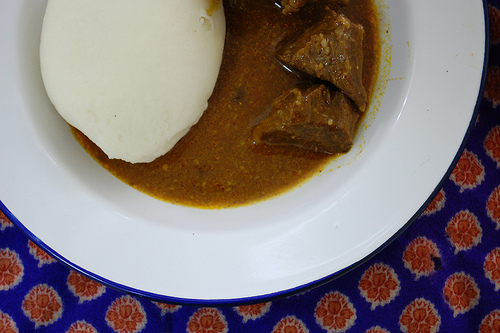




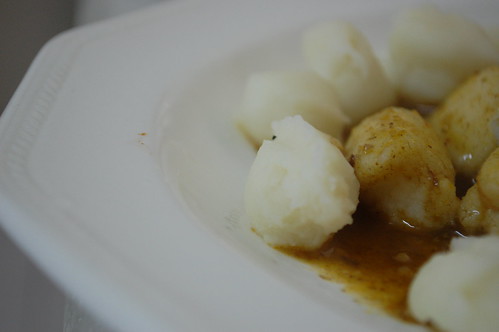
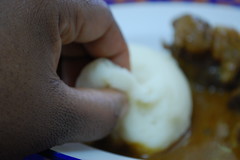
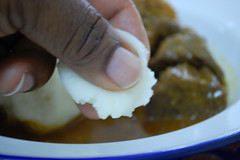
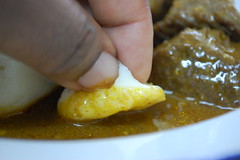
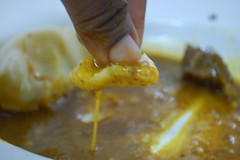
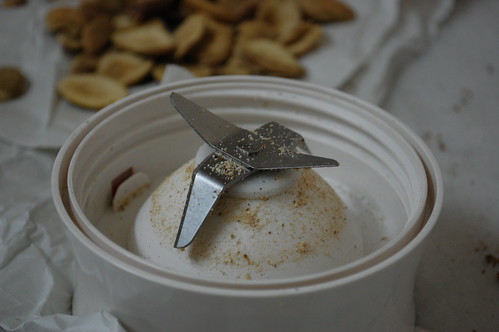

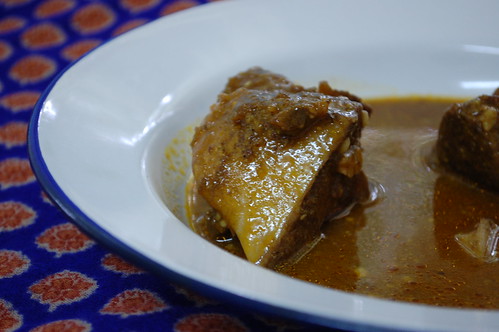


Hi Oz, thanks a lot for your recipe and explanation for what Ogbono means to you. Those narratives are so important to share.
I searched for your recipe as I bought Ogbono on the market in Amsterdam at Milly tropical. If you ever find yourself craving for Ogbono soup in the Netherlands now you know where to buy it.
Thank you!
Hello, I live in Nigeria and I can help source for any local foodstuff you may need for your delicacies. Thanks.
Thank you.
[…] semovita, tripe, urhobo soups I was blog trolling one saturday afternoon and came across Kitchen butterfly’s ogbono soup pictures and holy moly I could not stop thinking about Ogbono soup that day. The next day I ran to the […]
[…] – in the North/middle belt of Nigeria, it is sliced into thin strips, dried a bit and added to ‘soups’ for texture. Typically, we eat it ripe, or just ripe. When the flesh is firm to soft, and when its […]
I just tried this dish using this recipe. My soup turned out very grand. This is the best Ogbono I can ever remember making. I had a fab time eating it, making all the nice noises at same time, and very Glad I made some for a tomorrow. Thanks Oz and good work!
Thanks my love! Glad it worked out!!!!! Chei, no stockfish sha…love you loads!
[…] familiar with it? I’ll tell you. It’s an eating soup, in the manner of other Nigerian eating soups – really stews, that’s thickened with crushed melon seeds (in the family and […]
[…] dishes these unconventional food parts make their way into are varied. Peppersoup. Soups. Stews. Ogbono. Vegetables. But I find them most delicious in peppery, tomato-based sauces (stews, as we […]
[…] I loved when I was ten years old. It means too that we can discover new things together like tree squirrels dancing on tree branches, things that make it not only my place, but our […]
[…] plants, as they open and close. It means too that we can discover new things together like tree squirrels dancing on tree branches, things that make it not only my place, but our […]
[…] Kitchen Butterfly just posted a recipe for Nigerian Ogbono Soup on her blog. […]
[…] By hand. Forget cutlery. And decorum. […]
[…] kids ate Eba, with some soup as we returned – honest, Nigerian cooking. The Eba was made from white garri which they […]
[…] would call some varieties ‘surf and turf’ as they combine seafood and […]
[…] January 30, 2013 Leave a comment I was blog trolling one saturday afternoon and came across Kitchen butterfly’s ogbono soup pictures and holy moly I could not stop thinking about Ogbono soup that day. The next day I ran to the […]
For those who wants to learn how to cook Oghwo soup na only an urhobo woman will teah you correctly or her neighbours. Not to be mean you wont find it on this blog. There is an Urhobo blog its alled cookingncleaning.blogspot.co.uk. You can find all the urhobo dishes here. Esp the correct way to cook Ameidi soup which is the banga soup as it came from this tribe.
Sandra, thanks for leaving a message. As a full Wafi babe, with an Isoko mum and an Urhobo husband, :-), questions on Ogwho and Banga are very welcome and will be answered in due course. Thanks for the link too to cookingncleaning.blogspot.co.uk – its a blog I read often. Cheers
I never used to like ogbono soup because I always felt nauseated after eating but i later realised that sometimes one buys the wrong seeed thinking its ogbono. I went to see a friend and she called her sister in law in the village whom she asked to get me the real ogbono seeds. First thing i noticed when i cooked it was that i ddnt need to put a lot of the ground ogbono to get the consistency i wanted in my soup and its wonderful. The nausea isnt there also. Since i got that ogbono my husband doesnt want anything for lunch but ogbono soup with cowtail served with wheat.
Kitchen butterfly, the blog helped me today, am kind of man that love cooking, no kind of Africa food that I can’t cook . Since I left African many years ago I forgot some recipes,but I can’t forget Africa dishes is the best for me. Even do am far away from home . Last week I bought apon, am from Yoruba tribe so, I followed up the cooking recipes and it was delicious ummmm… Thanks to kitchen butterfly so helpful blogs
I love your blog! My husband is from Nigeria and we live in the U.S. so it is hard to find ingredients for his favorite meals, but your substitutions helped so much!!!
Ugiri is different from Ogbono. Quite close but different. Lets just say Ogbono is the authentic louis vuitton while ugiri is the copy made in china. Ugiri seed/nut is larger than ogbono seed/nut. Ugiri is cheaper and not as valuable cos its thickening effect and taste is not as good as ogbono. (Maureen from Igbo speaking part of Nigeria)
[…] something was wrong with the photo: The person in the photo was eating with his or her left hand. See lefty Ogbono photos Africans are brought up with a strict eating etiquette that expressly warns: “Never, Ever eat […]
My Utmost respect to you. Well Done! I am in awe of you.
Can you teach me to cook OGWHO? This was an oil soup I had in Delta State in a visit to a funeral. I loved it. It was used as a curry sauce on chips, boiled yam, and as a soup for pounded yams, pure starch dough – coloured yellow with palm oil, and types of cassava dough.
[…] soups in Ghana, in contrast to thickened Nigerian soups are ‘light’ in consistency and serve dual purposes of dipping and drinking. Also, […]
I have a lot to catch up on!!! Wow, you moved back – now you will be posting all sorts of Nigerian dishes I bet. Exciting! I tasted a small bit of Ogbono soup at a Nigerian restaurant and yes – the flavor was FABULOUS but I still couldn’t embrace that mucilaginous quality. Though I think I could acquire a taste for it? I do like okra so who knows? Looking forward to reading about your adventures!
This is sure a great website, just stumbled upon it and it got me salivating.Great hints particularly the one on removing salt from bacon.The Peppersoup and Ogbono soup hmmmmmmmm.I am starving already cant wait to get home.Well done for this, great source, just sent the link to my colleagues and they want to try the peppersoup because i told them it is a good cure for colds.
Thanks for your comments. Trying to unpack boxes…and paralysed by the weight of not doing anything!!!!!! Lots of love
Sigh … this is such a beautiful post … full of longing for home, wonder at the differences between Netherlands and Nigeria, and information for those of us who have no knowledge base of African cuisine … welcome home, dear! Lovely photos, wonderful story!
How fun to read this post, especially as I know very little about African cuisine (which is probably too broad a term in and of itself!). I too am fascinated by the many overlaps in the world’s food –besides dumplings (ps I love Czech dumplings) there’s the cleverness in using up old bread for example. I have to admit it’s that gummy quality that I don’t like much about okra, but I would be willing to try this even so (yours OR your mom’s!). It looks so homey and comforting!
Interesting and new ingredient to me. Wonder if I can get Ogbono powder here in Aussie. Will have to find out
This sounds like an intriguing soup! I love gelatinous soups by the way, my favorite is includes oxtail. Good idea to serve babies gelatinous broth. Definitely worth trying.
What a great chance to experience foods for different countries and cultures. Something I would love to do first hand. I am always excited when you post Nigerian recipes…something I am not familiar with, I can just imagine the warmth and flavors coming from that dish!
hey oz! every post of yours makes the reader travel along with you.. this time it’s nigeria. so many interesting facts beautifully narrated. thanks for that. i am going to try our traditional tamilnadu style yam masala curry now.
I always love your posts. SO educational, as I learn about food I’ve never even heard off. I’m craving soup!
The color wouldn’t bother me at all, OZ, but the mucilaginous bit is always a killer for me. Lovely post, sounds like you’re very glad to be home.
Echoing Celia – a joy to read and packed with so much of interest. Your reporting is meticulous – I feel I am going on a Nigerian food journey every time I visit these pages. But you had me at mucilagenous…yes I’m in that 50% of the world that hates that texture….with a passion!
takes me back to Africa. I did learn to love the okra sauces in Mali. I had a Togolese friend there, and the food she make sounds a lot like this. It was so good!
Lovely post, and delicious looking soup! Something so completely new to me – it was a great joy to read, thanks Oz!
I love your story. It is beautifully written.
The soupl looks awesome and I am very curious about this yam. Perhaps you could describe exactly what ingredients you use and how you prepare it. I think I ate it once in my life and I loved it.
Thanks and enjoy your day!
Thanks Anja.
Yams are to Nigerians what potatoes are to the west – cooked, boiled, fried, roasted, baked and what not. They are often mistaken in the States, for sweet potatoes but are not. They are root tubers, generally long, about 50 – 60 cm with brown sandy outers and creamy flesh.
To cook, they are peeled and the white is fashioned into a meal. There are 2 options to make pounded yam: cook yam flour into a paste, like choux pastry or boil chunks of yam and when soft, pound to a paste in a mortar and pestle. The latter method is not as popular as it used to be some 10 years ago, largely because it is physically strenuous to pound yam….and the advent of great tasting yam flour. Hope you can recreate your memories…..someday. XX
What an utterly beautiful post. I love your writing, it transports me right into your kitchen in Nigeria. Your photos are equally evocative. Just stunning.
The butterfly shot is gorgeous!
The dish is like surf and turf all in one soup. Can you package some up and send it my way?
Wow – what a great post! Beautiful photo’s and a look at a cuisine that I would never normally have any exposure to. Thanks Oz!